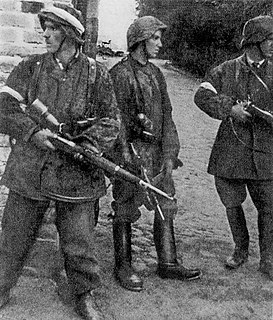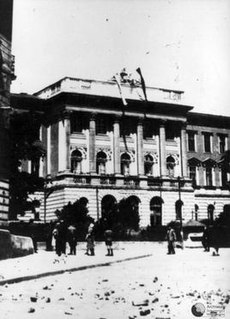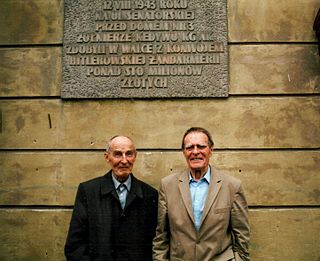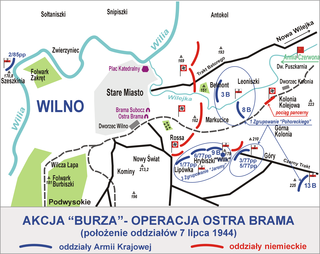 W
WThe 1943 Pinsk Prison raid was one of the most spectacular raids in the history of the Home Army and the Polish Underground State. It took place on 18 January 1943 in Pinsk, the town in Eastern Poland, which at that time was under German occupation as part of Reichskommissariat Ukraine. The purpose of the raid was to release a Cichociemni agent and his comrades, who had been captured by the Germans while trying to blow up the Horyn river bridge.
 W
WThe V-2 missile launch site, Blizna was the site of a World War II German V-2 missile firing range. Today there is a small museum located in the Park Historyczny Blizna in Blizna, Poland. After the RAF strategic bombing of the V-2 rocket launch site in Peenemünde, Germany, in August 1943, some of the test and launch facilities were relocated to Blizna in November 1943. The first of 139 V-2 launches was carried out from the Blizna launch site on 5 November 1943.
 W
WAction Ghetto - code name for the armed actions of the Polish Underground State during the Warsaw Ghetto Uprising aimed at helping the insurgents. The name was given to a series of combat actions carried out by the Home Army during the uprising between 19 April 1943 and May 16, 1943.
 W
WThe Lwów uprising was an armed insurrection by the Home Army underground forces of the Polish resistance movement in World War II against the Nazi German occupation of the city of Lwów in the latter stages of World War II. It began on July 23, 1944 as part of a secret plan to launch the countrywide all-national uprising codenamed Operation Tempest ahead of the Soviet advance on the Eastern Front. The Lwów uprising lasted until July 27. Shortly afterwards, the Polish troops were disarmed, soldiers merged into the Polish communist armed forces and officers arrested by the Soviet NKVD. Some were forced to join the Red Army, others sent to the Gulag camps. The city itself was occupied by the Soviet Union.
 W
WOperation Most III or Operation Wildhorn III was a World War II operation in which Poland's Armia Krajowa provided the Allies with crucial intelligence on the German V-2 rocket.
 W
WThe Operation Arsenal, code name: "Meksyk II" was the first major operation by the Szare Szeregi Polish Underground formation during the Nazi occupation of Poland. It took place on March 26, 1943 in Warsaw. Its name was coined after the Warsaw Arsenal, in front of which the action took place. The plan was to free the troop leader Jan Bytnar "Rudy", who was arrested together with his father by the Gestapo. The operation was executed by 28 scouts led by Warsaw Standard Commander Stanisław Broniewski "Orsza". The initiator and the commander of the "Attack Group" was Tadeusz Zawadzki "Zośka".
 W
WOperation Góral was an action carried out by the Polish anti-Nazi resistance organization Home Army, which involved a heist of over a million US dollars' worth of currency being transported by Nazi German authorities on 12 August 1943. It was carried out in the center of Warsaw by a unit of Kedyw, "Motor", which seized a transport car carrying the money. It was one of the best organized actions of the Polish underground during the German occupation, and it took only two minutes.
 W
WOperation Kutschera was the code name for the successful execution of Franz Kutschera, SS and Reich's Police Chief in German-occupied Warsaw, who was shot on 1 February 1944 by a combat sabotage unit of Kedyw of the Home Army mainly manned by members of scouting and guiding Gray Ranks. This special action was a part of the larger Operation Heads - the code name of a series of executions of Nazi officials by the Polish Resistance.
 W
WOperation Ostra Brama was an attempt by the Polish Home Army to take over Vilnius from Nazi Germany's evacuating troops ahead of the approaching Soviet Vilnius Offensive. A part of a Polish national uprising, Operation Tempest, the action began on 7 July 1944 and lasted until 14 July 1944.
 W
WDuring World War II, the Polish resistance Home Army, which conducted military operations against occupying German forces, was also heavily involved in intelligence work. This included operations investigating the German Wunderwaffe: the V-1 flying bomb and the V-2 rocket. British intelligence received their first Polish report regarding the development of these weapons at Peenemünde in 1943.